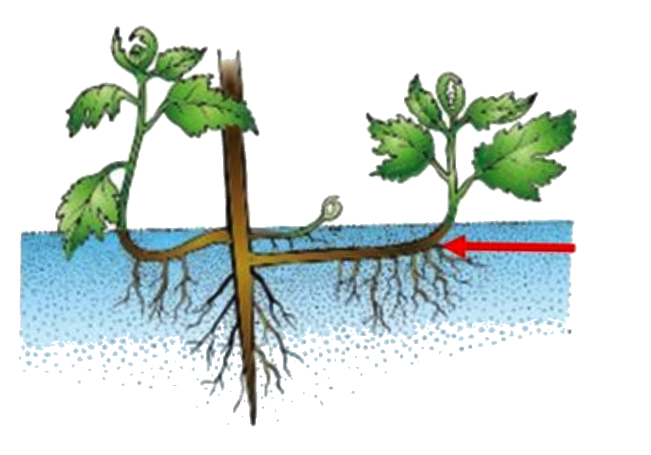Which of these modification of stem is incorrect ?
A lateral branch with short internodes and each node bearing a rosette of leaves and a tuft of roots is found in a aquatic plants like pistia and Eicchornia.
In banana , pineapple and chrysanthemum, the lateral branches originate from the basal and underground portion of the main stem, grow horizontally beneath the soil and then come out obliquely upward giving rise to leafy shoots.
In plants like mint and jasmine a slender lateral branch arises from the base of the main axis and after growing aerially for some time arch downwards to touch the ground.
Axillary buds of stems may also get modified into woody , straight and pointed thorns which are found in many plants such as cucumber and pumpkin.
The correct Answer is:D
To solve the question "Which of these modifications of stem is incorrect?", we will analyze each of the provided statements regarding stem modifications and identify which one is incorrect.
1. Analyze the first statement:
- The statement describes a lateral branch with short internodes, each node bearing a rosette of leaves and a tuft of roots, found in aquatic plants like Pistia and Eichhornia.
- This is a correct description of "offsets," which are modifications of the stem used for vegetative propagation in aquatic plants.
2. Analyze the second statement:
- This statement refers to banana, pineapple, and chrysanthemum, stating that lateral branches originate from the basal and underground portion of the main stem, growing horizontally beneath the soil and then coming out obliquely to give rise to upward shoots.
- This is a correct description of "rhizomes" in banana and "stolons" in pineapple and chrysanthemum, which are indeed modifications of the stem.
3. Analyze the third statement:
- The statement mentions plants like mint and jasmine, where a slender lateral branch arises from the base of the main axis, grows for some time, and then arches downwards to touch the ground.
- This is a correct description of "stolons," which are also a form of stem modification.
4. Analyze the fourth statement:
- This statement claims that the axillary buds of the stem may give rise to woody, straight, pointed thorns found in plants such as cucumber and pumpkin.
- This statement is incorrect because cucumber and pumpkin do not have thorns; they have tendrils, which are modifications of the stem used for climbing. Thorns are found in plants like citrus and bougainvillea.
Conclusion:
Based on the analysis, the incorrect modification of the stem is stated in option four. Therefore, the answer to the question is:
Option 4: The axillary buds of stem may also give rise to woody, straight, pointed thorns which are found in many plants such as cucumber and pumpkin.
- The statement describes a lateral branch with short internodes, each node bearing a rosette of leaves and a tuft of roots, found in aquatic plants like Pistia and Eichhornia.
- This is a correct description of "offsets," which are modifications of the stem used for vegetative propagation in aquatic plants.
- This statement refers to banana, pineapple, and chrysanthemum, stating that lateral branches originate from the basal and underground portion of the main stem, growing horizontally beneath the soil and then coming out obliquely to give rise to upward shoots.
- This is a correct description of "rhizomes" in banana and "stolons" in pineapple and chrysanthemum, which are indeed modifications of the stem.
- The statement mentions plants like mint and jasmine, where a slender lateral branch arises from the base of the main axis, grows for some time, and then arches downwards to touch the ground.
- This is a correct description of "stolons," which are also a form of stem modification.
- This statement claims that the axillary buds of the stem may give rise to woody, straight, pointed thorns found in plants such as cucumber and pumpkin.
- This statement is incorrect because cucumber and pumpkin do not have thorns; they have tendrils, which are modifications of the stem used for climbing. Thorns are found in plants like citrus and bougainvillea.
Based on the analysis, the incorrect modification of the stem is stated in option four. Therefore, the answer to the question is:
Similar Questions
Knowledge Check
- Question 1 - Select One
Corm is the modification of
ARootBLeafCStemDBud
A modification of petiole is -
View SolutionCorm is a modification of –
View Solutionwhich of the following modification of stem protects the plant from following animals and reduces transpiration?
View SolutionPick up the leaf modification
View SolutionWhich of these plants have a modification of stem as indicated by the red arrow , in this diagram ?
 View Solution
View SolutionStapes is modification of :−
View SolutionGenetic modification has
View Solution
